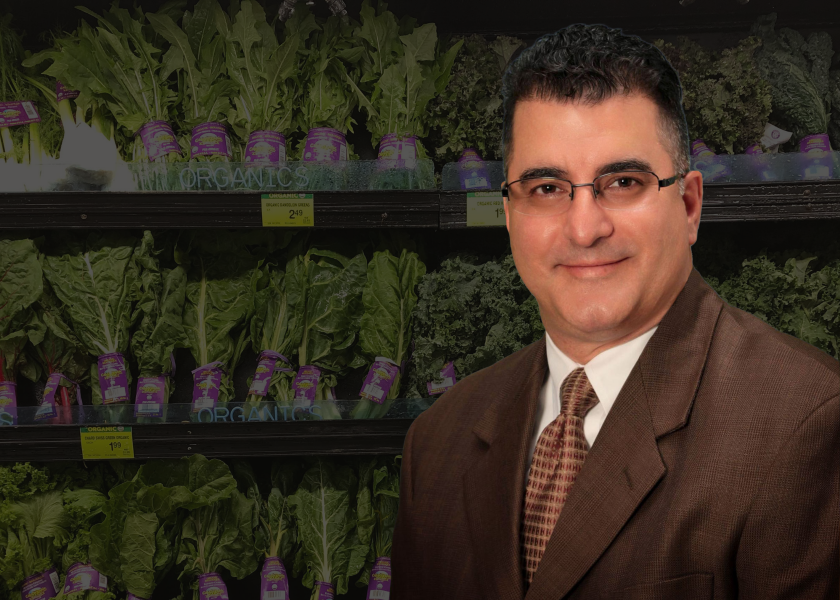Fumasi looks at changing outlook for organic fruits and vegetables

Opportunities still outweigh challenges for organic produce growers and marketers, Roland Fumasi said at The Packer’s 2021 Global Organic Produce Expo.
Fumasi, North American regional head for RaboResearch Food & Agribusiness, outlined the challenges and concluded with the opportunities for organic fruit and vegetable marketers in a Jan. 26 address at the virtual GOPEX event.
Challenges, he said, include both domestic and import competition. Looking at the organic market in a 2017 research paper, Fumasi recalled that he was bullish on organics. At the same time, he warned then that oversupply can happen fast. That still rings true today, he said.
“One thing I know we’re good at in agriculture, and that is producing food, so we have to be careful and keep an eye on the supply side,” he said.
Fumasi said that the Biden administration may be more actively involved in promoting organic food, which is a potential positive for future demand. The administration may also look to create incentives for greater organic production, which is good for the industry but may create downward price pressure for some crops.
On the import side, the U.S. doesn’t have specific organic coding in trade statistics for every type of fruit and vegetable product, so the data is not precise.
Still, for the organic data that is reported, Fumasi said U.S. imports of organic fruits and vegetables have increased 125% overall in the past five years. Within that group, organic blueberry imports over the past five years have increased 25-fold.
Greenhouse peppers and tomatoes, he said, also have experienced massive increases in organic imports.
The increased risk and cost of organic production compared with conventional produce is another persistent reality, he said.
Compared with 10 years ago, Fumasi said that organics has become mainstream at retail stores, which is a positive. However, he pointed out that fact also makes it harder for marketers to differentiate brands and particular produce.
“By definition, if something is mainstream, then it is not as differentiated,” he said.
He said that consumer willingness to pay for organic also differs. With excess supply of organic produce, the additional supply must be marketed to more price-sensitive consumers after the needs of core consumers are satisfied.
“If we get supply and demand wrong, (there is) risk because of the price sensitivity of the majority of consumers,” he said.
Sales record
Fumasi said consumer demand for organic produce has increased during the COVID-19 pandemic.
“I think that in this virus-stressed environment, people are gravitating toward food that they see as more healthful,” he said.
Compared with a 10% increase in all produce sales in the second and third quarters of 2020, Fumasi said that organic produce sales were running 15% higher.
“Just like previous years, organic growth is absolutely outpacing the general produce category,” he said. Sales of organic produce also have been less erratic than conventional produce, he said.
“Organic vegetables did outperform organic fruits, and we think that the most likely cause in that is the big change in eating occasions, now that we’re all working remotely and spending more time at home,” he said, noting that cooking vegetables are heavily used at home, especially for dinner.
Increases in organic sales have been volume-driven, he said, as second-quarter prices of organic produce last year were actually 1% down, and prices held steady in the third quarter.
“The increase in organics is outpacing the increases of the general category, but most of that increase is simply because consumers are buying more food at retail and less in foodservice,” he said.
Among fruit items, Fumasi said that organic apples have seen softer in recent years as volume has increased.
“Apples was one of the (commodities) that really came to the organic party pretty early, that really ramped up supply and probably got a little bit ahead of demand,” he said.
That has created downward pricing pressure for organic apples, Fumasi said, noting that apple organic supply is going through “right-sizing.”
On the other hand, organic blueberry volume has continued to increase because of demand.
Keeping the premium
Overall, Fumasi said the premium for organic produce over conventional produce is stable for many commodities.
“Our rule of thumb is always we’d like to see 40% (premium),” he said, while noting that some growers say they can still do well with 20% to 25% premiums.
Yet apples now only have about a 10% premium, and Fumasi said bankers would like that to be higher to account for the increased cost of production.
The premium for organic iceberg lettuce also has suffered a major decline over the past couple of years, he said.
Outlook
Recent sales statistics for organic produce look good, but Fumasi said one uncertainty is the “new normal.”
“The question becomes if a lot of this is COVID driven, what does the new normal look like?” he said.
Fumasi said it appears a substantial part of the population will be working remotely in “the new normal,” and that should be generally favorable for overall produce sales, conventional and organic.
Fumasi said RaboResearch Food & Agribusiness has a bullish medium- and long-term outlook for organic produce, with the caveat about the chance of oversupply for some commodities.
“We think that as millennial consumers continue to increase their earning power, that’s going to be another log on the fire, and we think they’re going to opt in for more organic,” he said.
Favorable government policy toward organic production will be another driver, he said.







